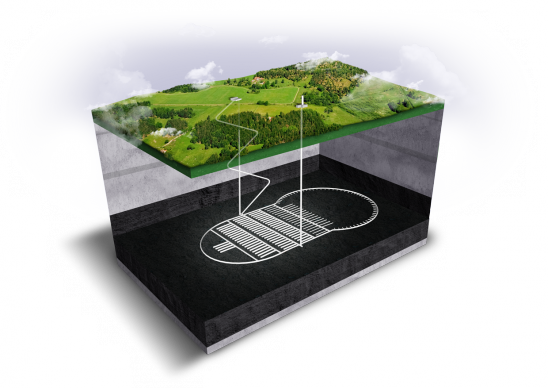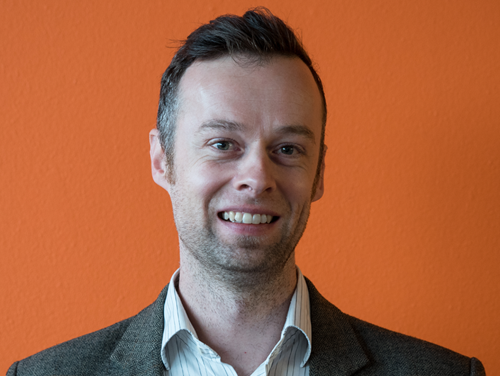Forget the pyramids. Engineers are designing final disposal repositories for radioactive waste that will outlive these ancient structures by a factor of twenty. But it is doubtful they will attract as many tourists.
One day our grandchildren will build a complex of tunnels going nowhere. The contours have already been drawn: a main tunnel will zig-zag its way down to a depth of a couple of hundred meters leading to a network of tunnels stretching for kilometres, with each tunnel intersected at fifty meter intervals by other tunnels terminating in a dead end.
After the complex has been completed a great many lorries transporting nuclear waste from Zeeland will be arriving to deliver their load to its final destination: a layer of clay or salt somewhere in the Netherlands. After that all will be quiet once more. It will be a place where no-one will ever have to set foot again.
Radioactive waste from several sources will be stored in steel and concrete containers tucked away in the intersecting tunnels, enveloped in clay or salt.
Opera
The disposal repository has been designed to last at least a hundred thousand years. The encasement of several layers of steel and concrete, the stability of the surrounding soil and the depth at which the waste is buried will ensure that the eventual migration time of waste through the soil will be long compared to the half-life of long-lived isotopes, says Ewoud Verhoef, acting director of the central organisation for nuclear waste Covra. Verhoef is responsible for the Opera research programme on the final disposal of radioactive waste.
Most of the programme’s projects were completed earlier this year and the results will be presented in November in cooperation with engineering society Kivi. Apart from TU Delft, TNO, Deltares, Belgium-based SCK-CEN and the British Geological Survey also contributed to the ten million euro research programme. Covra researcher Erika Neeft is the programme’s technical coordinator.
At present radioactive waste is stored in the orange bunkers near to the Borssele nuclear power station where it will remain for the next hundred years or so until heat production from the waste is past its peak. But the bunkers are not a long-term solution. ‘The final disposal repository is meant to cover a much longer period, between a hundred and a hundred thousand years,’ Neeft explains. ‘Geological disposal of nuclear waste is the only long-term solution we have. The material needs to be enclosed in the subsoil until it no poses a danger.’
Feasible
In the basement of the Civil Engineering and Geosciences faculty building, assistant professor Phil Vardon points out an apparatus which pressurises soil samples and measures the resulting minute distortions. The oedometer is about the only tangible part of the research that goes on in the Geoscience & Engineering department. The core of the work - a mathematical model describing what happens to the clay layer when put under different amounts of pressure and tension - only shows up as figures on a computer screen. Vardon uses results from experiments undertaken on Boom clay samples from Belgium.
Vardon and his colleague Patrick Arnold focused their research on the feasibility of an earlier design of a tunnel network. Could it be built at a depth of 500 meters? What would happen to the surrounding rock and what would be the consequences of the heat generated by the waste on the soil surrounding the tunnel?
The construction of the tunnel causes damage 10 to 15 meters into the rock. Heat generated in the tunnel increases the water pressure in the pores of the clay and affects strength and load bearing capacity. Nevertheless, Vardon, Arnold and their colleague Michael Hicks found that the design is feasible in principle as far as subsoil stability and heat production are concerned. It even seems possible to build the tunnels at a closer distance from each other (less than 50 meters between them) and that a lighter construction than proposed might be used.
Thorough
‘Vardon’s model shows how the concrete construction performs, not just under these particular circumstances but also as part of adapted future designs,’ Verhoef explains.
Various potential contenders submitted their proposals in the run up to the programme from which a number were chosen, says the programme’s coordinator Erika Neeft. TNO analysed the relevant subsoil samples from the Centraal Kernhuis, the organisation’s geological archive. NGO was involved in calculations of the mobility of various radioactive materials while Deltares visualised underground groundwater flows. The Belgian nuclear institute SCK-CEN provided clay samples from their High Activity Disposal Experimental Site (HADES). The British Geological Survey provided data on the porosity of the soil as a function of depth and Utrecht University carried out research into the binding of fission products in the subsoil.
Neeft is putting all the research project results together in a final report for next November’s presentation when more light will also be shed on the unknowns of the project. It is as yet unclear where in the Netherlands the facility will be located. Apart from the geological requirements much will depend on the attitude of the local population, Neeft says. ‘The local community must benefit from having a final disposal facility on its doorstep. Otherwise the answer will be no.’ But that bridge will not need to be crossed for some time to come.
Illustration: Covra
The picture at the top of the page was taken at The Underground Research Laboratory HADES (URL Hades) in Mol, Belgium, at a depth of 225 m in the Boom Clay formation. This picture was provided by the manager of the URL Hades, EIG Euridice, which is an economic interest grouping between the Belgian Nuclear Research Centre SCK-CEN and ONDRAF/NIRAS, the Belgian agency for radioactive waste and enriched fissile materials.
Published: October 2016
This story originally appeared on the website of TU Delta.





